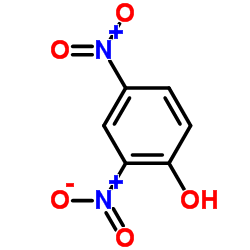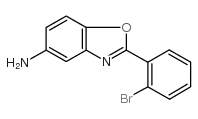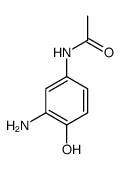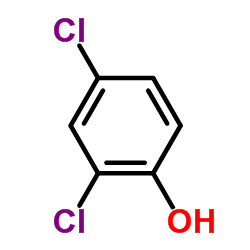2,4-Diaminophenol dihydrochloride

2,4-Diaminophenol dihydrochloride structure
|
Common Name | 2,4-Diaminophenol dihydrochloride | ||
|---|---|---|---|---|
| CAS Number | 137-09-7 | Molecular Weight | 197.062 | |
| Density | 1.343 g/cm3 | Boiling Point | 347.4ºC at 760 mmHg | |
| Molecular Formula | C6H10Cl2N2O | Melting Point | 222 °C (dec.)(lit.) | |
| MSDS | USA | Flash Point | 163.9ºC | |
| Symbol |

GHS06 |
Signal Word | Danger | |
| Name | 2,4-Diaminophenol dihydrochloride |
|---|---|
| Synonym | More Synonyms |
| Density | 1.343 g/cm3 |
|---|---|
| Boiling Point | 347.4ºC at 760 mmHg |
| Melting Point | 222 °C (dec.)(lit.) |
| Molecular Formula | C6H10Cl2N2O |
| Molecular Weight | 197.062 |
| Flash Point | 163.9ºC |
| Exact Mass | 196.017014 |
| PSA | 72.27000 |
| LogP | 3.32300 |
| Vapour Pressure | 2.68E-05mmHg at 25°C |
| Stability | Stable. Incompatible with strong oxidizing agents, acids. Heat and light sensitive. |
| Water Solubility | 27.5 g/100 mL (15 ºC) |
CHEMICAL IDENTIFICATION
HEALTH HAZARD DATAACUTE TOXICITY DATA
MUTATION DATA
|
| Symbol |

GHS06 |
|---|---|
| Signal Word | Danger |
| Hazard Statements | H301-H315-H319-H335 |
| Precautionary Statements | P261-P301 + P310-P305 + P351 + P338 |
| Personal Protective Equipment | dust mask type N95 (US);Eyeshields;Faceshields;Gloves |
| Hazard Codes | Xi:Irritant; |
| Risk Phrases | R22;R36/37/38 |
| Safety Phrases | S26-S36 |
| RIDADR | UN 2811 6.1/PG 3 |
| WGK Germany | 3 |
| RTECS | SK7600000 |
| Packaging Group | III |
| Hazard Class | 6.1 |
| HS Code | 29222900 |
|
~90% 
2,4-Diaminophen... CAS#:137-09-7 |
| Literature: Mischenko; Alexandr P.; Gryaznov; Vladimir M.; Gakh; Igor G.; Parbuzina; Iraida L.; Savitsky; Evgeny M.; Polyakova; Viktoria P.; Roshan; Natalia R. Patent: US4323708 A1, 1982 ; |
| Precursor 1 | |
|---|---|
| DownStream 10 | |
| HS Code | 2923900090 |
|---|---|
| Summary | 2923900090 other quaternary ammonium salts and hydroxides。Supervision conditions:None。VAT:17.0%。Tax rebate rate:9.0%。MFN tariff:6.5%。General tariff:30.0% |
|
Responses of the L5178Y tk+/tk- mouse lymphoma cell forward mutation assay to coded chemicals. I: Results for nine compounds.
Environ. Mutagen. 9(2) , 143-60, (1987) Nine substances were tested for their mutagenic potential in the L5178Y tk+/tk- mouse lymphoma cell forward mutation assay, by means of procedures based upon those described by Clive and Spector (Muta... |
|
|
NTP Technical Report on the Toxicology and Carcinogenesis Studies of 2,4-Diaminophenol Dihydrochloride (CAS NO. 137-09-7) in F344/N Rats and B6C3F1 Mice (Gavage Studies).
Natl. Toxicol. Program Tech. Rep. Ser. 401 , 1-232, (1992) 2,4-Diaminophenol dihydrochloride is used in the manufacture of dyes and as a color accelerator in photographic developers. Toxicology and carcinogenesis studies were conducted by administering 2,4-di... |
|
|
[Preparation of antibody erythrocyte for indicating arbovirus antigens].
Vopr. Virusol. (1) , 98-102, (1982)
|
| 2,4-Diaminophenol dihydrochloride |
| 2,4-Diaminophenol |
| MFCD00012979 |
| Phenol, 2,4-diamino-, hydrochloride (1:2) |
| 2,4-diaminophenol,dihydrochloride |
| EINECS 205-279-4 |

 CAS#:293737-80-1
CAS#:293737-80-1 CAS#:102-33-0
CAS#:102-33-0 CAS#:13676-48-7
CAS#:13676-48-7 CAS#:13676-47-6
CAS#:13676-47-6 CAS#:120-83-2
CAS#:120-83-2 CAS#:116248-09-0
CAS#:116248-09-0 CAS#:116248-11-4
CAS#:116248-11-4 CAS#:116248-10-3
CAS#:116248-10-3 CAS#:851402-83-0
CAS#:851402-83-0 CAS#:90915-19-8
CAS#:90915-19-8
